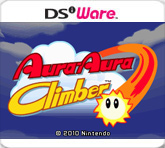| Aura-Aura Climber | |
|---|---|
 | |
| Developer(s) | Nintendo Software Technology |
| Publisher(s) | Nintendo |
| Director(s) | Masamichi Abe |
| Producer(s) | Yukimi Shimura Kensuke Tanabe |
| Designer(s) | Stephen Mortimer |
| Programmer(s) | Rory Johnston |
| Artist(s) | Kunitake Aoki |
| Composer(s) | James Phillipsen |
| Engine | DSiWare |
| Platform(s) | Nintendo DSi (DSiWare) |
| Release |
|
| Genre(s) | Action |
| Mode(s) | Single-player |
Aura-Aura Climber is an action video game developed by Nintendo Software Technology for the Nintendo DSi's DSiWare digital download service. It was released on February 22, 2010.